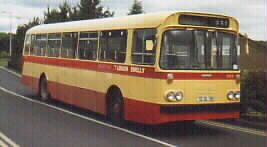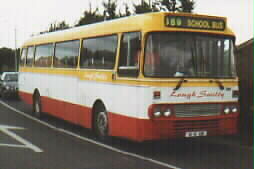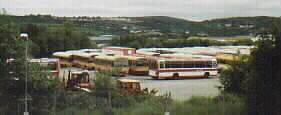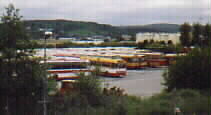
|

|
| Background | Timetables | Route Map | Vehicle Types | Fleet List |

|

|
The L&LSR is close to unique in being a Northern Ireland company operating almost entirely in the Republic of Ireland, and possibly because of this it doesn't 'fit in' to official models on either side of the border particularly well, and maybe tends to be ignored. Up to a few years ago, the only place I had heard of it was a brief mention in the Ulsterbus Timetable where it states the different public transport services that a blind person's free bus pass is valid on.
This page describes the history of the Lough Swilly company; there is also a route / timetables page, a route map, a vehicle types page and a fleet list. The pictures above are of an ex-Ulsterbus Alexander (Belfast)-bodied Leyland Leopard and an ex-Clydeside (Glasgow) Alexander (Scotland)-bodied Leyland Leopard, two bus types featured prominently in the Lough Swilly fleet over recent years.
Originally to have been called the Lough Foyle and Lough Swilly Railway Company, the company was incorporated with its current title in June 1853, with the aim of building a railway line to connect Lough Foyle and Lough Swilly (on either side of the Inishowen Peninsula in North Donegal). The railway had been decided on in preference to a canal scheme. The standard-gauge line between Derry and Farland Point on Lough Swilly (on the shore opposite the south coast of Inch Island) opened 10 years later on 31st December 1863. This was intended to connect with Steamboats operating on Lough Swilly. You can see where these places are on the Lough Swilly Route Map.
During construction it was decided to also build a branch line northwards to Buncrana, and this opened later on in 1864. The Farland Point branch wasn't used very much and was closed in 1866. In 1883 most of this branch was re-opened and extended to Letterkenny as a narrow gauge line. Lough Swilly didn't really own this line but they ran the trains on it. The original line to Buncrana was changed to narrow gauge in 1885. An extension line from Buncrana to Carndonagh opened in July 1901, and the Letterkenny and Burtonport Extension Railway from Letterkenny to Burtonport via Dungloe opened in March 1903.
During all this time and for the first three decades of the 20th century, the Lough Swilly company rarely made any profit; if it ever did it would have been mainly only used for paying off debts. It would seem that the railway was inherently unprofitable, and indeed was only able to be built and run with very large amounts of government assistance and subsidy. Especially on the Burtonport extension line, many of the train stations were situated quite a long way away from the villages they served, and against this background Lough Swilly started to change over to road transport and bus operation.
The first bus operations started in November 1929 when the business of a bus operator operating between Buncrana and Derry was taken over. More take-overs continued in 1930, and a large acquisition of buses and routes in the North West took place in 1931, which was when the Swilly Bus Services really took off. Up to 1930 large losses were being made; a smaller loss was made in 1931, and after that the company started to pay off its debts and eventually became profitable. James Whyte became General Manager of the L&LSR in 1931; he was to remain in that position for the next 36 years overseeing the eventual closure of all the railway lines and complete move over to road transport (passengers and freight).
The first railway line to close was the extension from Buncrana to Carndonagh, in about 1934/35. At about this time also Lough Swilly acquired a lot of lorries and started to move from rail- to road-freight. In 1940 part of the line from Letterkenny to Burtonport was closed, although the line wasn't all lifted until after the second world war so some trains still ran until then. In the late 1940s only the Derry to Letterkenny and Derry to Buncrana lines were left. The last train ran on 1st July 1953, although for a few years before that only only goods trains went to Buncrana, while Letterkenny might have had passenger / goods services until the end.
After 1953 all the work of the railway was performed by buses and lorries. The current route map dates from the mid-1950s. The first double-decker bus was acquired in 1948 for use on the Buncrana route, and double deckers were then later also used on the Carndonagh, Moville and Letterkenny routes. The 1950s and early 1960s were probably the best times for the company; it would have been making a profit and been able to buy new buses and everything was going quite well. In the early 1970s it was operating a coach service from Letterkenny to Glasgow in conjunction with Western SMT in Scotland.
I suppose about this time there would have been declining amounts of people using buses and things like that and maybe bus operation just wasn't becoming as profitable as it had been. I don't know how the Swilly Freight business affected the overall company's fortunes, but they were declining anyway. The troubles and disturbances in Derry in the late 1960s and early 1970s affected business, and there was also competition from unlicensed operators. In the 1970s the link between the Irish and UK currencies was broken, and the Irish pound became worth less than the pound Sterling. This would have caused an extra financial burden, as most of the revenue came in Irish money, but being a UK company Lough Swilly had to pay its employees in Sterling. The last regular batch of new buses came in 1966, and after that almost all the buses were second hand. Better maintenance procedures were also put in place to make the buses last longer---quite important on the bad roads in Donegal.
Some help came in the form of hired / lent buses from CIE (Irish public transport operator) in 1974, and this continued over the next few years. This was mainly as a result of the Lough Swilly company asking for help from the government. Initially neither government (UK or ROI) would help them, because of the unique position mentioned earlier. Eventually the Irish government offered a small amount of help in the form of these 'lent' vehicles. Second-hand buses were also bought in from companies in England and from Ulsterbus.
The company made a loss in all the years from 1973 to 1978. A tiny profit was made in 1979 but there were still many debts. Things were looking very bad for the Londonderry and Lough Swilly Railway Company when it was saved in 1981 by being purchased by an English property developer who was formerly from Buncrana, Patrick Doherty. I think this would have changed the legal status of the company in that it had originally been set up and then extended by different government acts, and now it is more like a private company. If anybody knows anything about how this worked out, I would be interested if they could email me.
The pattern of buying second-hand buses from English operators and from Ulsterbus has continued right up to today. None have been obtained from Ulsterbus since the late 1980s, and a lot have been sourced from Scottish operators recently (see the Lough Swilly Vehicle Types page). Some sort of subsidiary or sub-division, Swilly Tours, was set up in about 1986. Two new Volvo B10M coaches and a quite new Leyland Leopard were purchased for it; the Volvos are still the newest buses in the fleet today and occasionally operate tours to concerts and things like that in Dublin. I'm sure they also do more local tours around Donegal, and they are regularly used on the Derry to Letterkenny Express service as well.
Since the 1960s Lough Swilly has operated a lot of official school buses in North Donegal, and a separate fleet of buses is kept for this. It currently has a separate livery from the normal passenger service fleet. At the minute the school buses are red, white and yellow. A few years ago they were red and cream, which is the livery I think the Swilly Freight lorries are still in. The passenger buses have a red and white livery, although I think this was red & cream in the 1980s. Lough Swilly certainly seems to change its liveries quite regularly.
Since the start of the company its main headquarters was in Pennyburn in Derry. It had a bus depot there until November 1997, but this then closed and the buses and lorries are now housed on the same site in the Springtown Industrial Estate, further out the Buncrana road in Derry. I think the main office is in Foyle Street Bus Station, and the company now calls the Pennyburn address its 'registered office'. There is a large modern depot in Letterkenny (behind Letterkenny Shopping Centre). In front of this is a big field where lots of old dead withdrawn buses are parked. Recently a lot of the old buses were being scrapped, but I think there has been a drop in the price of scrap metal and so a lot of the old buses will be staying on for a bit longer. Some photographs of Letterkenny depot are shown below.


Lough Swilly Letterkenny Depot
So in 4 years time (2003) the L&LSR will be 150 years old. It's really quite a good record and today it's still doing the work it was founded for in 1853: moving people and goods between Derry and north Donegal. The Border has caused a lot of problems, but if it wasn't for it I don't think the Lough Swilly company would still be here today. Let's hope then that even if the border ever disappears, the Londonderry and Lough Swilly Railway Company is here to stay.
Northern Ireland Bus Site |
| Index | Ulsterbus Page | Citybus Page | Lough Swilly Page | Links |